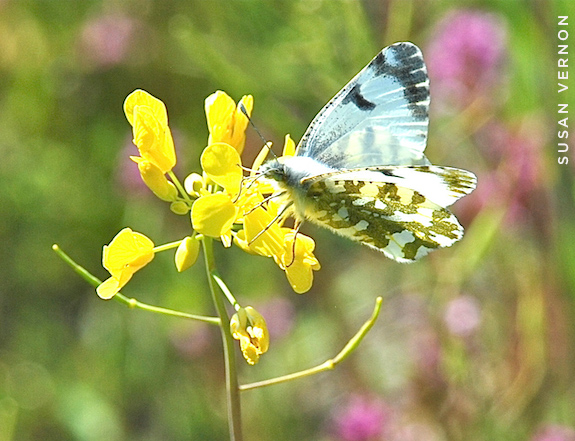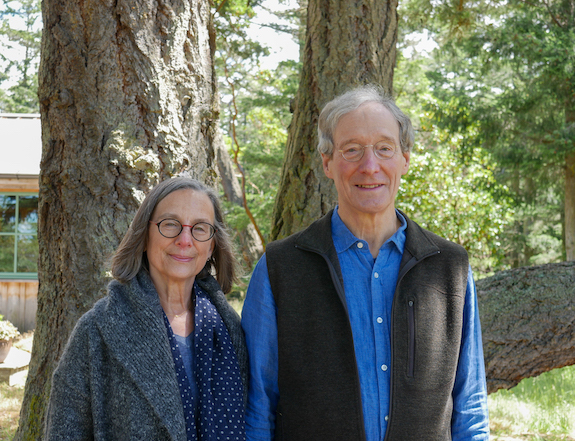Island Dispatch | Summer 2019
DOGS IN NATURE PRESERVES
We love dogs, but …
Staff Archive
Take a walk in any public park or nature preserve and, if you didn’t bring your own canine companion with you, you’re bound to run into other people who did. The Preservation Trust’s policy is that we welcome well-behaved dogs in our preserves that are open to the public—but only when their owners are also well-behaved enough to keep their dogs leashed.

“Amelia” Flies To Frazer Preserve | Susan Vernon
BUTTERFLY BREAKTHROUGH
For the last several years, the only place in the world where the Island Marble Butterfly was known to live was in a few small patches on the seaside prairie at American Camp, near the southern end of San Juan Island.
That changed in late May, when a lone Island Marble was seen flitting among yellow field mustard blooms in one of several habitat patches that San Juan Preservation Trust staff and volunteers have been cultivating since 2015 on the County Land Bank’s Frazer Homestead Preserve, near American Camp.
“It was so exciting to see our work paying off,” says SJPT Stewardship Manager Kathleen Foley, who leads the Island Marble Habitat Expansion project. “This was exactly what we’ve been hoping and working towards for four years.” Kathleen nicknamed the butterfly Amelia, after another adventurous female flyer.
“Amelia’s” appearance at one of SJPT’s habitat plots was significant: It was the first confirmed sighting of an Island Marble outside of American Camp in years. Even better, though, she stayed and laid eggs! Most of the 18 eggs hatched into caterpillars. After maturing, they will form a chrysalis and, if all goes well, emerge as butterflies next spring—a hopeful step for this exceedingly rare insect, which has been proposed for federal listing as an endangered species.
“These exciting developments speak to the integrity of the initial design of the Preservation Trust’s habitat patches,” says Susan Vernon, a San Juan Island naturalist who has been deeply involved in Island Marble conservation efforts since they began more than 15 years ago. “Creating the conditions that encourage this butterfly to repopulate historic breeding areas has been hard work, but it seems like ‘Amelia’ found just what she was looking for.”
PROTECTING A PEACEFUL ISLAND HILLTOP
Rain showers played tag with sunshine one morning in early June, when Kip and Stanley Greenthal welcomed a visitor to their Lopez island home. They live on 25 wooded acres atop Pavey Hill, a prominent rise near Mud Bay. “There are lots of vistas from up here,” Stanley said. “A pair of eagles comes to visit the hill every day.” Just then, an olive-sided flycatcher whistled its distinctive song, “It’s ME here! Let’s BE here!”
Kip and Stanley were both born in New York City and met some thirty years later on Lopez. Since then, they’ve commuted between Pavey Hill and Seattle, where Kip worked in libraries and schools, eventually founding and directing Seattle Arts & Lectures’ Writers in the Schools program. She’s also a writer. Stanley, an internationally renowned professional musician, composes and performs world folk music, performing on the guitar and several other stringed instruments.
The Greenthals donated a conservation easement on their property to the Preservation Trust in 2018. They were motivated, in part, by long-term economics: By reducing the tax value of their land, the easement makes owning the property more affordable for them and, potentially, for their heirs.
Even more compelling for Kip and Stanley, the conservation easement ensures that their 25 acres, comprised of 13 tax parcels, will always remain intact and undeveloped—for the sake of their children, grandchildren (who love visiting!), and all future generations of people and wildlife.
“With all the worries about global warming,” Kip said, “there’s something very pleasurable and fulfilling about maintaining a property to be ‘forever wild,’” as the easement stipulates.
Smiling broadly, she added, “I love that term, ‘forever wild!’”

